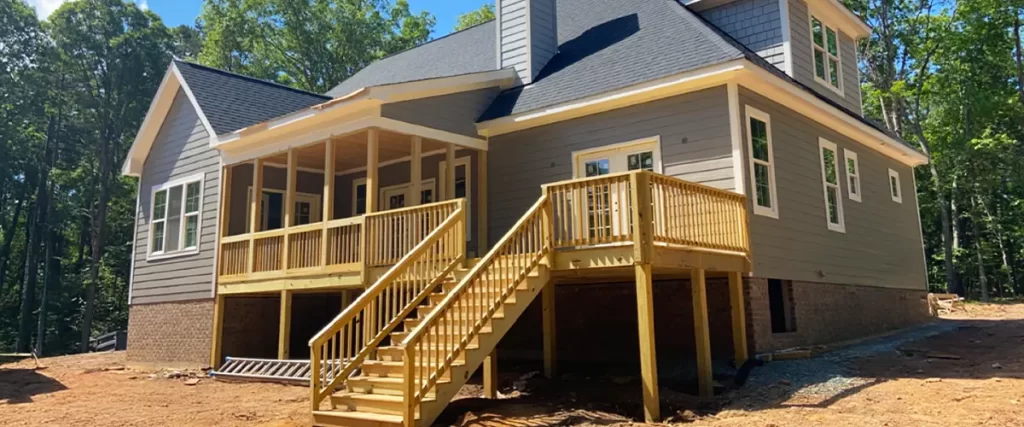If you’re a homeowner in Pinehurst, especially in neighborhoods like Old Town Pinehurst or the Country Club of North Carolina (CCNC), you probably know that adding a deck isn’t as simple as sketching your dream design and calling a builder.
Between HOA regulations, historic district restrictions, and local permitting requirements, building a deck here takes more than just a good idea—it takes a clear understanding of the rules.
And let’s be real: navigating all that red tape can be overwhelming.
That’s why we created this comprehensive guide. Whether you’re upgrading an existing deck or dreaming of a brand-new outdoor oasis, we’ll walk you through everything you need to know to stay compliant and creative.

Why Pinehurst Is Unique (And Why That Matters for Your Deck)
Before we dig into the rules, let’s take a second to appreciate why Pinehurst is different. We’re not just any North Carolina town—we’re home to history, tradition, and some seriously iconic architecture.
Climate Considerations
Pinehurst’s mild winters and hot, humid summers make decks a popular addition. But this also means you’ll want to choose materials and finishes that can stand up to UV exposure, moisture, and the occasional ice storm.
Historic Character
Neighborhoods like Old Town Pinehurst are part of a designated Historic District. That’s not just a cool fact—it carries real implications for how, where, and even if you can build or alter a deck.
Deck Rules in Pinehurst’s Historic Districts
Old Town Pinehurst is governed by the Pinehurst Historic Preservation Commission (HPC). If your property falls within the district, here’s what you need to know.
Permitting & Certificates of Appropriateness (COAs)
Before building or modifying a deck in a historic area, you must apply for a Certificate of Appropriateness (COA) from the HPC. Even something as minor as changing deck railing materials requires approval.
What the HPC Looks For:
- Design compatibility with the existing architecture
- Materials that reflect historic character (think wood, not composite)
- Visibility from the street—more visible projects get more scrutiny
- Size and scale relative to your home and neighbors
Pro Tip: The HPC meets monthly, so plan ahead. Waiting until summer to get started might mean you’re BBQ-ing in the fall.
👉 Learn more and apply for a COA here (City of Pinehurst)
HOA Rules in Gated Communities Like CCNC
If you live in CCNC or other HOA-governed neighborhoods in Pinehurst, your deck plans will also need to pass the Architectural Review Committee (ARC).
What Most HOAs in Pinehurst Care About:
- Location: Decks can’t be built too close to property lines or neighboring homes.
- Aesthetics: Design and color often must match the home’s existing palette.
- Height and privacy: Tall railings or multi-level structures can be a red flag.
- Landscape integration: Decks may need to blend naturally with existing trees and slope.
Most HOAs require submitting your deck plans, including material samples and structural drawings, for review. If you’re part of CCNC, you’ll want to reference their HOA Design Guidelines (check the members portal).
Pinehurst Deck Building Permits: What You Need to Know
Even if you’re not in a historic area or under HOA rules, every deck over 30 inches off the ground or attached to your home requires a permit in Pinehurst.
What You’ll Need:
- A site plan
- Detailed construction drawings
- Material descriptions
- Proof of setback compliance (distance from property lines)
Inspections are required at various stages, including footing, framing, and final. Skipping the permit process can result in fines or having to tear down your deck altogether—not fun.
Apply through the Village of Pinehurst Planning & Inspections Department.
Materials Matter: Choosing Deck Options That Pass Inspection
Depending on your neighborhood, certain materials may be frowned upon—or outright denied. Historic districts generally require traditional materials like pressure-treated wood, cedar, or mahogany.
HOAs may be a bit more lenient and allow composites like Trex, but usually only if the finish and color match the house.
Avoid bright colors, plastic-looking materials, or modern metal railings unless they’re approved.
Best Decking Manufacturers for Pinehurst Homes
When choosing materials for your deck, opt for brands known for durability, aesthetics, and compliance with historic and HOA standards.
- Trex – Low-maintenance composite with a natural wood look; often approved by HOAs.
- TimberTech – Offers wood-alternative decks with a real-wood texture and excellent fade resistance.
- Fiberon – Known for eco-friendly decking and classic tones that blend well in traditional neighborhoods.
- Cali Bamboo – Great for sustainability-focused homeowners, with a natural wood finish.
- Ipe Woods USA – Premium hardwood option; ideal for historic homes looking for authenticity and longevity.
Top Tips for Navigating the Process
- Get approval before you build. Always.
- Document everything. Photos, plans, HOA letters—keep it all.
- Work with someone who knows Pinehurst regulations.
- Think ahead about maintenance and materials.
- Don’t assume what worked for your neighbor will work for you.

Frequently Asked Questions (FAQ)
Do I need a permit for a ground-level deck in Pinehurst?
If the deck is under 30 inches in height and not attached to your home, you may not need a permit—but always check with the Pinehurst Planning Department to be sure.
Can I use composite materials in a historic district?
Generally, no. Most historic districts require natural wood for any visible exterior elements. You might get approval if the material is indistinguishable from wood.
What’s the fastest way to get my deck approved in an HOA community like CCNC?
Submit a complete application with clear renderings and material samples. Pre-approval conversations with the ARC can also save time.
How long does it take to get a Certificate of Appropriateness in Old Town Pinehurst?
It varies, but expect at least 4-6 weeks from submission to approval if your project is straightforward. More complex designs may take longer.
Can I build a covered deck or screened porch instead?
Yes, but those structures usually require more detailed plans and stricter reviews from both HOAs and the HPC.
Final Thoughts: Build Smart, Stay Compliant, and Enjoy Your Pinehurst Deck
Building a deck in Pinehurst isn’t just about adding outdoor living space—it’s about honoring the charm and legacy of our historic, highly regulated town. Whether you’re navigating the strict guidelines of Old Town or the pristine aesthetics of CCNC, your best bet is to plan early, know the rules, and stay flexible.
If you’re ready to move forward but still have questions—or need help understanding the deck building process, contact us at (910) 985-8064. We’re local experts who know the ins and outs of Pinehurst deck regulations, and we’re happy to help you every step of the way.
